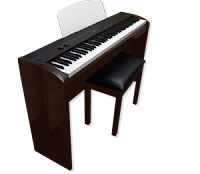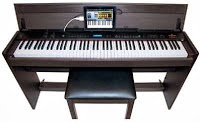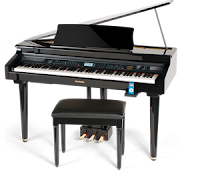UPDATED REVIEW – December 1, 2014 – NOT RECOMMENDED –
Suzuki MDG200, SD10, SL1, DP1000, HP99 – I first wrote this review over two years ago when some of these pianos first came out, and since then the some of them have been discontinued. The current models are the HP99, SD10, SL1, and MDG200 micro grand. The MDG200 Micro Grand is basically the exact same piano as the Suzuki DG10 Micro Grand normally found at Costco US. Go to the following link for my review of the DG10: Suzuki DG10 Review. The other Suzuki models I reviewed here are not offered on the Suzuki web site any longer. I still do not recommend any of the Suzuki digital pianos because of poor key action response and unrealistic piano sound as well as poor pedaling function.
 |
| Suzuki SL1 |
Suzuki digital pianos have been around for a long time and the Suzuki name is fairly well known for violins and piano & violin teaching methods as well as for motorcycles, cars, and other consumer products. There are also Suzuki acoustic upright and grand pianos too. In the case of Suzuki pianos, this (piano) company has nothing to do with the non-musical Suzuki products and services you see in other places. The Suzuki piano company is independent and owned apart from most other Suzuki products and the digital pianos are produced by an unknown Chinese digital piano factory.
In my opinion it does not really matter where a piano is made and who makes it, as long as it is a good quality instrument which closely (as much as possible) plays like a real acoustic upright or grand piano, has good construction, and is reliable. I have played all of the new Suzuki digital pianos and put them through their paces and the most important things necessary in digital pianos is key action feel, tone quality & velocity response, proper damper pedal movement along with sustain & half damper response, and finally construction. The Suzuki’s do look like quality digital pianos but there are some definite problems with their playability in my opinion. The DP1000, R21, & HP99 are identical in key action movement and piano sound velocity response in how hard or soft you press the keys.
Good velocity response means that the volume of the piano sound plays evenly and gets progressively louder or softer depending on how hard you push on the keys. After playing these pianos I noticed the Suzuki R21 – $995 internet discount (above left pic), DP1000 polished ebony – at Costco for $999 – left pic) but also on-line at music store sites for $1495, HP99 – $1795 internet discount (below left pic), & TSI-1ei – $1695 internet discount (not pictured) all have a problem in this area. The key touch velocity & dynamic response is very uneven and the sound is not smooth and gradual in volume (because of that) when playing the keys. Simply put, this would likely be due to inexpensive electronics/key sensors in the piano along with the physical parts used in the key action. Suzuki uses the same key action and basic electronics in all their pianos so the results are unfortunately the same in all models.
The #1 most thing in a digital piano (and piano teachers look for this too) is getting a properly weighted key action movement. Also, when you press a key down softly as far as it can go, you should hear no sound at all. That is normal in acoustic pianos. In the Suzuki pianos mentioned here, the piano sound actually is triggered about half way down so you hear the sound even before the key gets to the bottom…not a good thing. This will throw off your ability to play with proper dynamics and note timing, especially if you are a beginner and just learning. These things are not something which is apparent when first playing the pianos, especially if you have little or no experience with pianos. But after awhile it will become important as you progress with lessons or if you play and try to use proper soft to loud dynamics. Play any new Casio, Yamaha, Kawai, or Roland and you will not find this issue in those pianos.
 |
| HP99 |
The resonance of the piano tone is also very shallow and short when holding down the damper pedal especially on the upper half of the piano keys. Add to that situation the problem of the damper pedal (right pedal) which is used often for sustaining (holding) the note for a while after you release the key, does not function as acoustic pianos do. On an acoustic piano, when you press the damper sustain pedal (right pedal) down to get full sustain, the sustaining tone is supposed to gradually let off as the pedal comes back up, and not just immediately stop as the pedal starts going back up. In the digital piano world, gradual up & down sustain is called “half-damper.” Yamaha, Casio, Roland, Kawai, and a couple other brand names have this feature but Suzuki does not. Suzuki only has sustain “on or off” (like most inexpensive keyboards do) and that is definitely an issue in my opinion, especially for the piano student or player as they progress to higher skill levels.
My favorite saying is that “you cannot judge a book by its cover” and that’s true for pianos as well. The Suzuki digital pianos overall look attractive (most of the cabinets that are in the basic dark rosewood color also come in polished ebony for more money) and sound OK (nothing special compared to the other brands) and can even be price competitive for what they “seem to offer,” but the reality is they do not come close to playing at all like real acoustic pianos (even at minimum standards as far as I’m concerned).
 |
| Suzuki SD10 |
As far as reliability, additional features, and warranty, that is unimportant if the basics aren’t right although my personal experience has not been too good with Suzuki digital piano reliability in the past. In fact, when I once played the DP1000 in a Costco, the sustain pedal was not working at all and it was plugged in properly… not a good sign. The DP1000 (and the newer SD10) does have some cool features including drums, chords, multiple sounds, iPod docking tray, and is in an attractive polished black cabinet (SD10 is in satin black). But the key action and volume/dynamic response is just not acceptable in my opinion if you want a good playing experience for yourself or your kids, or other members of the family. For all the digital upright style models Suzuki offers incl their small (cute looking) digital baby grands, I would stay away from them and move on to other brands including Roland, Yamaha, Casio, and Kawai. Those pianos work well, sound great, have useful features and most importantly, do what pianos are supposed to do.
 |
| MDG200 |
The current model MDG200 micro grand, SD10 small vertical cabinet piano with folding lid, and the SL1 portable piano on stand all share the same key action, many of the same sounds, pedaling functions, features, and velocity volume response electronics. Although a lot of the digital features on these pianos are pretty cool, Suzuki misses the mark when it comes to the playing fundamentals of piano, in my opinion. The SL1 at $599 Costco price is the least expensive piano that is offered and it’s just the little brother of the SD10. I have done a full review of the SD10 and my comments there apply to all current model Suzuki pianos. Go to the following link for my SD10 review: SD10 review
I really did want to like these Suzuki pianos, but unfortunately I could not. I have also reviewed in detail a couple of their other Suzuki models in the past which can be found on the following links:
















I have a Suzuki SS-100 digital piano. Three of the keys do not make any sound. Could you shed some light on the probable causes. As I see it, the keyboard key connects to solder points on the circuit board when depressed. Is it possible that the key is dirty or bent which might cause contact not to be made? Rhode
I am not a technician nor would be able to know specifically the cause of such issues. It could be a number of things. Please call Suzuki America direct and I'm sure they'll be glad to help you.
Dear Tim, I've spent hours searching for this valuable information with absolutely no luck until I found your website. Thank you so much! I very nearly fell prey to the cute Suzuki Baby Grand with my lack of knowledge.
Regards
Nic
Thanks, Tim. Very informative and specific. Sounds like even at $130 used, it's not worthwhile. Best, Jay
Thanks for this honest review. I have a new Yamaha being delivered today – I almost started to second guess my purchase after seeing the attractive micro grand cabinet and host of features offered in the MDG200.
I have tried to play every digital piano I could find locally as I am fairly new to playing piano. I started out looking for tons of features and digital connectivity, and ended up buying a more minimalistic model (Yamaha P155) – which also has the best feel and most incredible piano sound (to me). As you say, this is really what matters when learning to play piano.
I have a cherry black suzuki digital piano R-21 that has a total of 88 keys,and 3 pedals and it also abke to record,my question is what is it really worth????
if it is in good working condition and appearance, its value is likely no more than $300-$400US at most
I got a DP1000 the paddle is not working I try to find how to fix it but I can’t find the cords